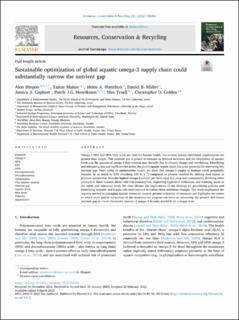| dc.contributor.author | Shepon, Alon | |
| dc.contributor.author | Makov, Tamar | |
| dc.contributor.author | Hamilton, Helen Ann | |
| dc.contributor.author | Mueller, Daniel Beat | |
| dc.contributor.author | Gephart, Jessica A. | |
| dc.contributor.author | Henriksson, Patrik John Gustav | |
| dc.contributor.author | Troell, Max | |
| dc.contributor.author | Golden, Christopher D. | |
| dc.date.accessioned | 2023-03-06T12:45:40Z | |
| dc.date.available | 2023-03-06T12:45:40Z | |
| dc.date.created | 2022-03-30T08:53:20Z | |
| dc.date.issued | 2022 | |
| dc.identifier.citation | Resources, Conservation and Recycling. 2022, 181 . | en_US |
| dc.identifier.issn | 0921-3449 | |
| dc.identifier.uri | https://hdl.handle.net/11250/3056066 | |
| dc.description.abstract | Omega-3 EPA and DHA fatty acids are vital for human health, but current human nutritional requirements are greater than supply. This nutrient gap is poised to increase as demand increases and the abundance of aquatic foods and the amount of omega-3 they contain may dwindle due to climate change and overfishing. Identifying and mitigating loss and inefficiencies across the global aquatic supply chain has great potential for narrowing this nutrient gap. Here, using an optimization model, we show that omega-3 supply to humans could potentially increase by as much as 50% (reaching 630 kt y−1) compared to present baseline by shifting feed inputs to produce species that have the highest omega-3 content per feed input (i.e. carp and crustaceans), diverting other production flows towards direct wild fish consumption, improving byproduct utilization, and reducing waste at the retail and consumer level. We then discuss the implications of our findings by prioritizing policies and identifying demand- and supply-side interventions to realize these ambitious changes. This work emphasizes the urgency needed in managing aquatic resources towards greater utilization of resources and highlights the extent to which even partial adaptation of the measures we propose can have on narrowing the present and future nutrient gap as novel alternative sources of omega-3 become available on a larger scale. | en_US |
| dc.language.iso | eng | en_US |
| dc.publisher | Elsevier B. V. | en_US |
| dc.rights | Attribution-NonCommercial-NoDerivatives 4.0 Internasjonal | * |
| dc.rights.uri | http://creativecommons.org/licenses/by-nc-nd/4.0/deed.no | * |
| dc.title | Sustainable optimization of global aquatic omega-3 supply chain could substantially narrow the nutrient gap | en_US |
| dc.title.alternative | Sustainable optimization of global aquatic omega-3 supply chain could substantially narrow the nutrient gap | en_US |
| dc.type | Peer reviewed | en_US |
| dc.type | Journal article | en_US |
| dc.description.version | publishedVersion | en_US |
| dc.source.pagenumber | 10 | en_US |
| dc.source.volume | 181 | en_US |
| dc.source.journal | Resources, Conservation and Recycling | en_US |
| dc.identifier.doi | 10.1016/j.resconrec.2022.106260 | |
| dc.identifier.cristin | 2013566 | |
| dc.relation.project | Norges forskningsråd: 268338 | en_US |
| dc.source.articlenumber | 106260 | en_US |
| cristin.ispublished | true | |
| cristin.fulltext | original | |
| cristin.qualitycode | 1 | |

